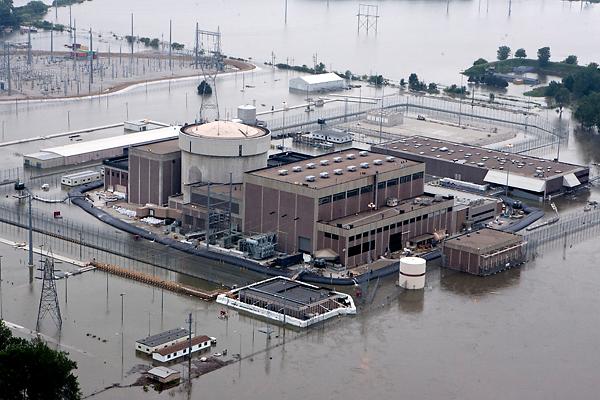
The Nuclear Regulatory Commission's insistence that the Fort Calhoun nuclear plant in Nebraska fix its flood protection deficiencies helped avert disaster when the Missouri River overflowed last summer. (Photo: Nati Harnik, Associated Press)
When negative reinforcement doesn't work, maybe positive reinforcement will. At least that's what Dave Lochbaum, the director of the Nuclear Safety Project at the Union of Concerned Scientists, is banking on.
UCS has published a number of nuclear safety reports since it was founded four decades ago, and Lochbaum--who worked at nuclear plants for 17 years before joining UCS in 1996--has written his share. The nonprofit science group repeatedly found that Nuclear Regulatory Commission enforcement is slow, erratic and ineffective. Over the years, the Government Accountability Office, the NRC's inspector general, and the agency's own internal assessments have come to similar conclusions.
Those reports, however, didn't spur the agency to up its game, so Lochbaum figured that the world didn't need yet another one. Two years ago, he decided to instead produce an annual report that documents not only what the agency is doing wrong, but what it is doing right. The goal? To prod the NRC--which can and does, at times, do a good job--to be more consistent.
UCS scheduled the release of the first annual report for mid-March of last year, and coincidentally, an earthquake and tsunami overwhelmed the Fukushima Daiichi nuclear plant in Japan just a few days before. All of the sudden, U.S. news organizations, which only sporadically cover nuclear safety issues unless there is a plant nearby, snapped to attention. After all, nearly a third of the 104 operating reactors in the United States are similar to the reactors at Fukushima. Nuclear safety became a national issue, not just a local one.
Lochbaum today released his second annual report, and his overarching conclusion is not that different than last year's: Many of the significant safety lapses at U.S. nuclear plants in 2011 happened because plant owners--and often the NRC--either tolerated known problems or failed to address them adequately.
The report, "The NRC and Nuclear Power Plant Safety in 2011: Living on Borrowed Time," documents the special inspections the NRC conducted in response to safety equipment problems and security shortcomings at 13 plants. Fortunately none of the 15 "near-misses" that triggered special inspections in 2011 harmed plant employees or the public, but, as Lochbaum points out, their frequency is high for a mature industry.
In keeping with his new approach, besides reviewing the special inspections, Lochbaum highlighted examples of where the NRC did an outstanding job last year addressing safety problems before they could lead to a potentially dangerous situation. But he also covered instances in which NRC negligence has continued to allow plant owners to flout agency regulations, sometimes for decades.
"Last year's record shows that the NRC is quite capable of being an effective watchdog that protects the public and saves the nuclear industry from its worst tendencies," said Lochbaum, a nuclear engineer by training. "But the agency too often does not live up to its potential, and we are still finding significant problems at nuclear plants that could too easily trigger a serious accident."
The 13 plants that experienced special inspections last year were Braidwood and Byron in Illinois, Callaway in Missouri, Cooper in Nebraska, Millstone in Connecticut, Monticello in Minnesota, North Anna in Virginia, Oconee in South Carolina, Palisades (two incidents) in Michigan, Perry in Ohio, Pilgrim (two incidents) in Massachusetts, Turkey Point in Florida, and Wolf Creek in Nebraska. The near-misses at Millstone Unit 2 and Pilgrim were the most threatening. Both involved an infrequently performed operation: a test of the valves controlling steam to the turbine at Millstone and a reactor startup at Pilgrim.
Three plants where the NRC nipped a problem before it became serious were Fort Calhoun in Nebraska, which was surrounded by Missouri floodwaters last summer; the Hatch plant in Georgia, where NRC inspectors found that safeguards instituted years before were inadequate; and LaSalle in Illinois, where agency inspectors identified a safety deficiency that had been overlooked for decades.
On the other hand, lax NRC oversight has allowed some problems to fester for decades. For example, the report points out that nearly half of the U.S. fleet--47 reactors--still do not comply with a fire regulation the NRC established in 1980 and amended in 2004. Fire represents 50 percent of the risk of reactor core damage. In other words, fire hazards are the equivalent of the risk from all other causes of core damage combined. Likewise, the NRC is aware that 27 reactors are currently operating with inadequate protection against earthquakes. The two reactors at the North Anna plant in Virginia, which sit 12 miles from the epicenter of the 5.8 quake that happened last August, are on that list.
Although Lochbaum reviewed all the special inspections last year, he did not cover all NRC actions, so the examples in his report do not necessarily represent the best and the worst of 2011. Regardless, the case studies shine a light on patterns of NRC behavior that contributed to both good and potentially dangerous outcomes.
"The serious accidents at the Fermi plant outside Detroit in 1966, Three Mile Island in 1979, Chernobyl in 1986, and Fukushima Daiichi last year happened when a handful of known, uncorrected problems resulted in a catastrophe," said Lochbaum. "The fact that U.S. plant owners could have avoided nearly all the near-misses in 2011 if they had addressed known problems in a timely manner suggests that they and the NRC have not learned the lessons of these accidents. Someday their luck may run out."
(Note: For more information about the safety status of each of the 104 operating nuclear power plants across the country, check out the Nuclear Power Information Tracker on UCS's website.)
Elliott Negin is the director of news and commentary at the Union of Concerned Scientists.
